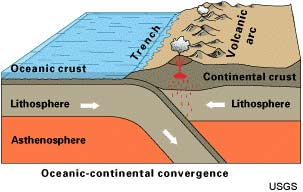Earthquakes can be predicted through slow slippage of tectonic plates
Recent studies have found that tremors are so small that it is difficult to perceive drugs on the earth's surface and may signal the enormous devastating earthquakes created by the Slow sliding of tectonic plates deep inside some types of faults.

Casscadia sinks in Canada.
(Photo: LiveScience)
These weak seismic cases, known as volcanic tremors and low-frequency earthquakes or dumb earthquakes, are mainly detected in subduction zones (subduction zone). The subduction zone is a type of fracture and is where a continuous tectonic plate runs down another tectonic plate. These faults are where one of the devastating earthquakes occurred in Indonesia's Sumatra island quake in 2004 created a tsunami that was incredibly destructive. .
Such devastating earthquakes often repeat after every 100 to 600 years, originating from a not-so-deep point in a fault. These earthquakes are often thought to occur after "dumb" earthquakes formed deep inside the faults and displaced the rock layers without making them wobble. These slow earthquakes usually last for days, months or even years but they are never recognized on the surface of the earth.
Gregory Beroza, a professor at Sanford University who researched the field, said: 'In Japan, the deep parts of the fracture where slow earthquakes are particularly important are because it is located next to the deep and silent part of the fracture where large earthquakes frequently occur. So every time a slow earthquake occurs, it increases the weight on the stand and increases the likelihood of an 8-degree earthquake. '
Fluid or sliding?
Although the links between these two earthquakes were generated by seismologists, they are not sure whether these tremors were created by liquid masses moving deep below the suction zone. sink or is created by tectonic plates sliding on each other.
These new analyzes, published in detail in the March 15 issue of the journal Nature, compared the seismic intensity of tremors to low-frequency earthquakes and they found that they had the same signs.
Beroza said: 'This explains that a low-intensity earthquake is actually a series of low-frequency earthquakes, each of which is caused by slippage at the deep part of the fault. A normal earthquake is also created by a similar mechanism but there is a difference. That is the slippage of a small earthquake deep underground that occurs slower than a normal earthquake. '

Frequency wave on April 1, 1946 in Hilo Harbor, Hawaii (Photo: Livescience)
Better forecast?
Observing these slow earthquakes can help predict larger earthquakes because slow earthquakes often occur before larger earthquakes and create more weight on tectonic plates that have created out them. However, the discovery of these tremors is very difficult and there is not enough data to clearly identify the links.
With a system of sensitive seismic devices installed by the Japanese government a decade ago, scientists have recently discovered these slow earthquakes that often appear every six months. once in the submerged zone near Shikoku island in Japan.
They hope that studying these tremors can help predict a major earthquake in Shikoku that is expected to happen within the next 40 years. The magnitude 8.1 earthquake happened on Shikoku Island in 1946 and killed more than 1,000 people.
Earlier this month, based on the shocking data, the Government of Canada announced that a massive sinking could happen in Cascadia (this area extends from northern California state to British Columbia province of Canada. ). Fortunately, this earthquake did not happen.
The Kiet
- The reason for Mexico's strong earthquake
- Found tectonic plate
- An earthquake occurred in Vanuatu, Mexico and China
- Determine the cause of earthquakes in Sichuan
- Earthquakes in China are very unusual
- Bali shakes due to earthquakes in the seabed
- Sichuan inspired more than 3,000 aftershocks
- Why do a series of big earthquakes attack Indonesia?
- The intensity of earthquakes in Nepal is equivalent to 20 atomic bombs
- China: There is a continuous earthquake in Sichuan
- Serpentine Stone: Potential risk of earthquakes
- Why does Japan have so many earthquakes?
 Is the magnetic North Pole shift dangerous to humanity?
Is the magnetic North Pole shift dangerous to humanity? Washington legalizes the recycling of human bodies into fertilizer
Washington legalizes the recycling of human bodies into fertilizer Lightning stone - the mysterious guest
Lightning stone - the mysterious guest Stunned by the mysterious sunset, strange appearance
Stunned by the mysterious sunset, strange appearance